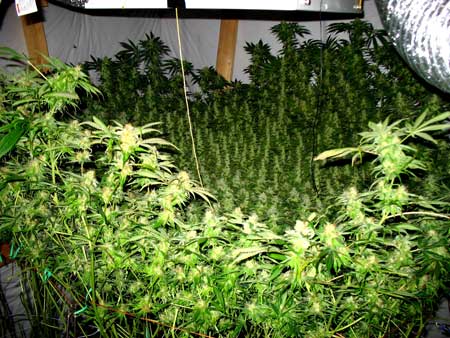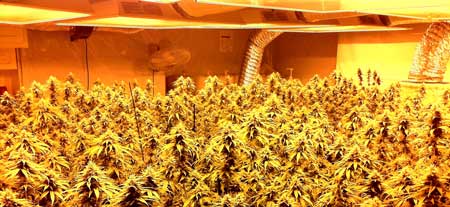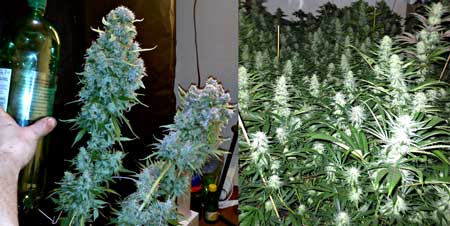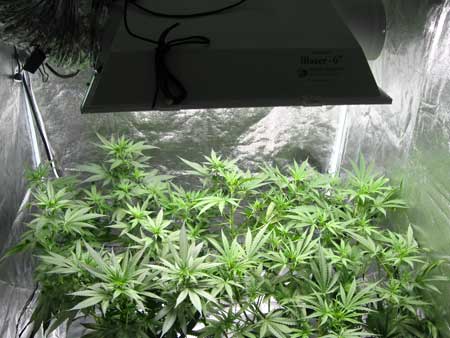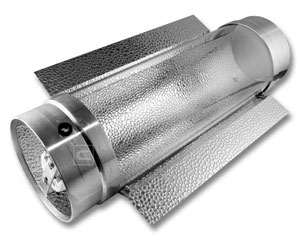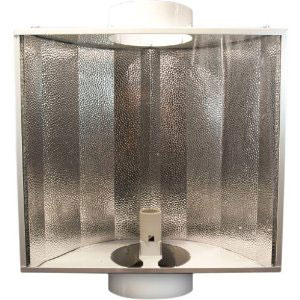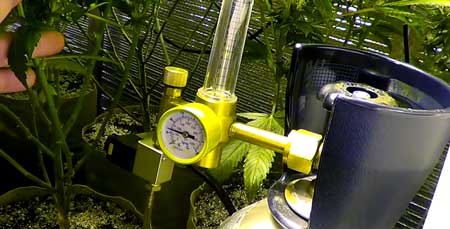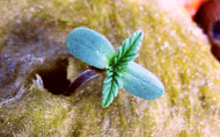You are hereCannabis Yields & CO2
Cannabis Yields & CO2
by Nebula Haze
Table of Contents
Introduction: Using CO2 For Growing Cannabis
How Do Cannabis Plants Use CO2?
CO2 Injection for Cannabis Growers
6 Most Common Ways to Add CO2 to Your Grow Room
- CO2 Generators & Compressed CO2 <-- Best Ways to Inject CO2
Introduction: How to Use CO2 For Growing Cannabis
How can cannabis growers use CO2 to increase cannabis yields? CO2 can increase your yields and growth by up to 20%, but a lot of people use CO2 the wrong way so they aren't getting any of the benefits.
This cannabis grower uses CO2 injection to increase yields!
Cannabis plants use CO2 when they're making energy from light, so without CO2 there's no photosynthesis or growth. However, most of the time there's already more than enough CO2 in the air for your plants. If your plant doesn't need more CO2, it won't help to add more.
For most indoor grows, there's already more CO2 in the air than your plants can use
But things are different when your space is bright. When there's more light than a cannabis plant can naturally use, supplying more CO2 can help your plants use more of that light. Getting more energy from the same amount of light results in faster growth.
Because of how this works, CO2 only increases growth when your cannabis plants are under very bright light (like the light from a 1000W HPS). But CO2 can be expensive. So before you ever think about adding CO2, it's a good idea to have completely optimized your cannabis grow space.
In order for CO2 enrichment to be effective, you need to maintail levels of 1200-1500 PPM of CO2 in your grow space
1200-1500 PPM of CO2
CO2 works best when everything else is optimal, and for most growers, a little optimization results in bigger returns than adding CO2. Only after you've dialed in all other factors of your grow is when it's time to think about adding more CO2.
Before adding CO2, you should optimize your grow space...
That means you've already got...
-
As much light as your plants can use (or more)
-
Fast & Healthy growth
-
You've maxed out what you can do with plant training
These things will all make a huge difference in your yields, often more than the gains you could get from CO2.
But after all that, adding CO2 may be the logical next step to get even more from your cannabis garden.
Because of all the misinformation out there, so many cannabis growers have wasted a lot of money on ineffective CO2 methods. I want to help growers understood exactly how CO2 enrichment works. That way you can set it up the right way and enjoy the benefits!
After years of research and study by commercial greenhouse growers, we've learned exactly what's needed to get the benefits of extra CO2.
Here are some factors to consider if CO2 will work for your cannabis garden.
For CO2 to work, you need....
-
Bright Light - Your cannabis plants need a lot of light for CO2 to be effective at speeding up growth and increasing yields. As far as light intensity, we're talking about the kind of light produced by a 1000W HID grow light. CO2 only helps plants make more energy from bright light, so it won't help if you have low light levels.
-
Enough CO2 - You must be able to maintain 1200-1500 PPM of CO2 in the grow area or it won't help your plants.
-
Sealed Grow Space - You must be able to completely seal your grow space so CO2 can't get out.
-
Temperature - You should maintain temperatures between 85°F (30°C) and 95°F (35°C) in your grow space for CO2 to be most effective.
-
Humidity - You must keep humidity below 60-70% to prevent mold and other problems, but keeping humidity low can be difficult with a sealed room while running CO2. You may need to get a dehumidifier.
I know it may sound like a lot, but these factors are important! If you have the wrong setup, adding more CO2 isn't going to help you! Today I will share everything I wish I’d known about CO2 when I started growing, so you'll know exactly how you can use CO2 for faster growth and increased marijuana yields. Let's get started!
Beware! Some people (especially companies selling poor CO2 products) will try to trick you into thinking that CO2 is some magical supplement you add to your grow room to make plants grow better. Unfortunately this is not the case! There are good ways to add CO2... and there are ineffective ways.
Pros and Cons of Using CO2 for Growing Cannabis
Benefits of Adding Extra CO2
-
Bigger Yields, Faster Growth - If you’ve maxed out the other limiting factors (especially light), CO2 can make your plants grow up to 20% faster, produce bigger plants, and enhance your yields.
-
Higher Temperature is Okay - Maintaining 1200-1500 PPM of CO2 in the grow area allows growers to keep temperatures much higher than normal. For growers with hot bright lights, this makes it easier to keep temps at a range their plants will like.
-
Security - CO2 enrichment can be beneficial for security since you’re not venting out smelly air (you must seal off the grow area for CO2 supplementation to be effective)
Disadvantages of Adding Extra CO2
-
Need Bright Lights - As far as light intensity is concerned, it's recommended that plants receive 7,500-10,000 lumens of light per sq foot for CO2 enrichment to be effective. To give you an idea...
Examples:
~600W HPS in a 3'x3' space
~1000W HPS in a 4'x4' space -
Must Seal the Grow Area - In order to keep CO2 near the plants, you must seal up grow area so it’s airtight, which can make it harder to manage temperature and humidity
-
Cost - It can be expensive to get started if you want to inject enough CO2 into your grow area to be effective. The best setups in the long run are a bit pricey to get started with, though they become a lot cheaper once you've got your initial supplies.
How Do Cannabis Plants Use CO2?

CO2 is short for "Carbon Dioxide," an odorless gas that’s in the air you’re breathing right now.
In fact, humans take in oxygen and let out carbon dioxide with every breath.
Humans Need Oxygen, Cannabis Needs CO2
Humans use their lungs to get oxygen, and in order to survive we need oxygen in the air at all times. Oxygen is delivered to our bloodstream and is needed for important body processes.
Similarly, plants need CO2 during the day as part of their important life processes. Instead of lungs, plants use hundreds of tiny pores in the leaves (known as stomata) to get CO2 out of the air. Like humans with oxygen, a plant will die if it doesn't get access to any CO2, because CO2 is needed for cannabis photosynthesis, the process of making energy from light. Taking away CO2 takes away the plant's ability to "eat."
Fun Fact: As a byproduct of photosynthesis, plants let out oxygen back into the air. The photosynthesis process generates most of the oxygen in our atmosphere. Without CO2 and photosynthesis, we would have no oxygen to breathe!
CO2 Injection for Cannabis Growers
In certain environments, indoor cannabis growers can add extra CO2 into their cannabis grow room during the light hours to increase the speed of plant growth.
When people are talking about how much CO2 is in the air, they generally measure in “PPM” or “parts per million.” In regular air, the amount of CO2 is approximately 300-400 PPM (about 0.03-0.04% of our air is CO2). But to get benefits from adding CO2 to your grow room, you need to add enough extra CO2 to maintain 1200-1500 PPM (0.12-0.15%) of CO2 in the air.
When CO2 concentrations get even higher, to 10,000 PPM (1% of air), it becomes poisonous to animals. Humans will suffocate at levels that high. In some cases greenhouse growers will use this to their advantage by raising the CO2 concentration to 10,000 ppm or more to kill bugs like spider mites (but of course they're careful to keep humans and animals far away!).
But since you'll be using much lower concentrations of CO2, it is very unlikely you'll ever expose yourself to negative effects. It's still always a good idea to protect yourself by staying out of the grow space as much as you can and otherwise reducing how much you breathe CO2-enriched air.
How can plants use more CO2 than what’s found naturally in the air?
A long time ago, there was a lot more CO2 in the air than there is now. Some scientists believe that this is why many plants can take advantage of more CO2 than what’s naturally found in the air.
Why is CO2 enrichment only effective during the “day” period?
Cannabis doesn't use CO2 when there's no light.
Like nearly all plants, marijuana stops using CO2 during the night (dark period). CO2 is primarily used in the day by the plant as part of photosynthesis (turning light into energy), so if there's no light, there's little need for CO2.
Therefore, flooding your grow area with CO2 during your dark period is a waste of time and money. CO2 only provides benefits when the lights are on.
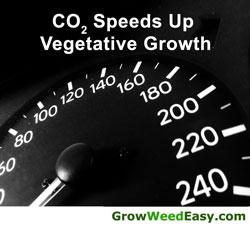
CO2 in Vegetative Stage
CO2 is most effective at increasing the speed of vegetative growth, so adding extra CO2 is one way to grow bigger plants in less time during marijuana’s vegetative stage of growth.
CO2 in Flowering Stage
Almost all growers seems to agree that you can get increased growth and bud production by running CO2 during the first 2-3 weeks of flowering.
After flowering is fully underway, some growers believe that CO2 is less effective, and it’s true that so far no one has been able to prove that CO2 can directly improve bud production beyond the first few weeks of the flowering stage.
However, a lot of growers feel from personal experience that running CO2 does increase bud production. Some growers recommend that you keep running CO2 all the way until 2 weeks before harvest.
When Should I Start Using CO2?
You need to have maxed out on almost all other growing factors and eliminated major growing problems to see the biggest benefit from adding CO2.
I’d like to point out that there are many free ways to increase your marijuana yields, such as plant training techniques, and mastering these first is going to be more effective in increasing your yields than adding CO2.
Before you consider CO2, you should eliminate any plant problems from your grow. I’d say that the number one way to increase your yields is to prevent plant problems. If you’re suffering from plant problems like too much nitrogen or nutrient deficiencies, you should start here when considering how to increase yields, since these will negatively affect your yields much more than any benefit you get from CO2.
If you’ve already mastered the basics of growing and have healthy plants in your garden, then training your plants properly in the vegetative stage and choosing the best grow lights you can afford are the next steps you should take to majorly improve your yields.
Mastering these factors will often be more effective for increasing your yields than adding CO2.
Your plants can only grow as much as allowed by the lowest limiting factor, and usually that factor is something else besides CO2.
It’s common for growers try to add CO2 to their grow area, without realizing that something else is limiting the growth of their plants.
Yet if you have already perfected the other factors of your grow, then adding the right amount of CO2 has been shown to increase overall vegetative growth by up to 20%. If you’ve maxed out your limiting factors and sealed your grow room, than adding CO2 could be the final piece to take your grow to the next level, providing you with quicker harvests, bigger plants and enhanced yields.
If you’re considering CO2 injection, ask yourself...
-
Have I already maxed out the amount of light my cannabis plants can use with my current grow lights? (at least 7500-10000 lumens per sq foot, usually only possible with a 600W or 1000W HID light, or a few 400W HID lights close together)
-
Have I already eliminated all problems from my grow such as nutrient problems, bugs, etc?
-
Have I already mastered (easy and free) growth control methods to increase my yields?
-
Am I willing to seal up my grow area so it’s airtight?
-
Can I maintain temperatures between 85°F (30°C) and 95°F (35°C) in my grow area?
-
Can I keep humidity below 70% in vegetative and 60% in flowering in my sealed room while running CO2? (Remember, if you use a CO2 generator, it will increase the humidity of the air dramatically so you may need to get a dehumidifier)
If your answer is “Yes” to all those questions, than CO2 enrichment may be right for you and your garden.
Supplementing CO2 is a great choice for those who have maxed out their other options and are willing to spend the money to do CO2 right. For these growers, supplementing with CO2 can increase the number of crops grown per year and allow them to grow bigger plants. If you’ve got a relatively big grow, the bigger yields will quickly pay for the CO2 investment.
The two most effective CO2 enrichment methods are using a CO2 generator or buying tanked or bottled CO2, combining your enrichment method with a CO2 regulator or timer. This lets you automate everything. Don't worry, we're going to walk you through the whole thing.
How to Get Your Space Ready for CO2
Tips to Get the Best Results with CO2
1.) Get the Right Size Grow Light for Your Space
A good rule of thumb is you should have 7500-10000 lumens per sq foot in your grow area to get the full benefits of enriching with CO2. You need high-powered grow lights like HPS bulbs for this rule to hold true.
To figure out if you have enough light, find out how much lumens your bulbs gives off. Then find the square footage of your space (length x width). Lumens/square footage should equal 7500-10000.
Examples of Setups with Enough Light for CO2 Injection
-
3' x 3' space - 600W HPS
-
3.5' x 3.5' space - 2 x 400W HPS
-
4' x 4' space - 1000W HPS
Learn more about HPS grow lights
You must be able to maintain 1200-1500 PPM of CO2 in the air of your grow area for CO2 enrichment to be most effective. Regular air only has about 400 PPM of CO2. That means that in order to maintain the right amount of CO2, you need to seal your grow space so your extra CO2 stays inside.
You must seal your grow room to keep all the extra CO2 inside
If you can’t seal your grow area so it’s airtight, then any CO2 you are adding will leak out and CO2 will return to normal levels. For the best results, you want the entire grow area to be sealed so the CO2 stays near your plants.
This means that you need to get rid of any possible air leaks when the grow space is closed. The only air getting in or out should be the air moving over your grow lights. You will keep this air segregated from your grow space by using ducting hooked up to the right type of reflector.
3.) Get the Right Reflector For Your Grow Light
Most growers need to cool their lights to keep temperatures in the right range. When chosing a reflector for your grow light, it's important to get one that is able to be cooled via ducting, without letting any of that air get inside the grow room and bring down your CO2 levels.
Cool Tubes
When it comes to your grow lights, a "Cool Tube" style hood is an effective reflector for your grow space. You can use ducting to bring cool air over your light from outside the grow space, then vent the hot air out without even touching the air in your grow space.
Cooltubes can keep your plants and grow lights cooler by trapping air and allowing it to be easily exhausted. They are suitable for CO2 enrichment because they let you exhaust heat from your grow lights without letting outside air touch your grow space.
Some cooltubes even come with an extra large reflector, which directs even more light down to your plants.
Air-cooled hoods
Air-cooled hoods have piece of glass or plastic which keeps hot air contained near the bulb (and away from your plants).
Many air-cooled hoods (like the one pictured here to the right) have the ability to be hooked up to ducting on both ends, which allows these hoods to be used for CO2 enrichment.
In other words, after you’ve sealed your grow room away from your lights, you can set up an intake and exhaust fan to blow air cool over the lights and have an exhaust fan vent out the hot air without also venting out all your CO2.
Learn more about the different parts of an HID grow light
Once you get your reflector, use ducting to allow air in and out of the sealed grow space, with the grow light & hood in the middle to rain light down over your plants.
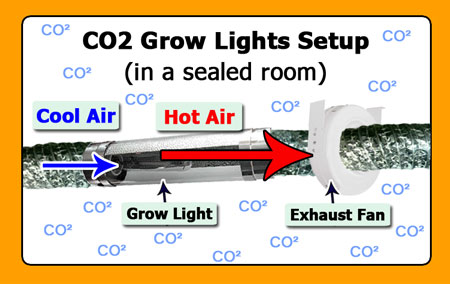
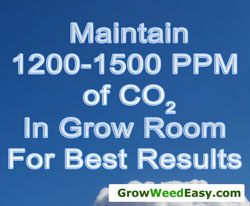 Growers
seem to agree that optimal CO2 is 1200-1500 PPM in your grow room. If
there’s less CO2 than that (especially under 1000 PPM), you won’t get
good results with CO2 supplementation. When the CO2 drops under 300
PPM, plant growth will slow down or even stop completely.
Growers
seem to agree that optimal CO2 is 1200-1500 PPM in your grow room. If
there’s less CO2 than that (especially under 1000 PPM), you won’t get
good results with CO2 supplementation. When the CO2 drops under 300
PPM, plant growth will slow down or even stop completely.
If you have a very small grow space (like the inside of a cupboard), then you may be able to maintain 1200-1500 PPM of CO2 in the area with one of the cheaper methods of CO2 enrichment since you won't need as much CO2.
If you’ve got a larger grow space (such as a closet, a grow tent, or a room) it will be hard to maintain enough CO2 in the air without investing in one of the more expensive options like a CO2 generator or compressed CO2.
There are 6 popular ways of adding CO2 to the air of your grow area...
-
CO2 Generator <-- Recommended
-
Compressed CO2 <-- Recommended
CO2 Generators and Compressed CO2 are the most effective ways to add CO2 to your grow area. I do not recommend any of the other methods. Learn why.
Get Your Own CO2 Generator or Compressed CO2
Tips to Get the Best Results with CO2
You must maintain very high temperatures, between 85°F (30°C) and 95°F (35°C).
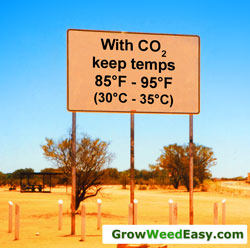 When you’re adding CO2, you will get the best results at higher temperatures.
When you’re adding CO2, you will get the best results at higher temperatures.
Normally you want your garden to be a comfortable room temperature, but when adding CO2, you want to keep temps above 85°F (30°C).
Many growers recommend you keep temps as high as 95°F (35°C).
If the temperature is lower than 85°F (30°C), you won’t see much benefit from adding CO2.
However, since you must seal your grow room to keep all the CO2 from escaping, it'll likely be easy to keep temps that high when you're running your grow lights.
CO2 should “fall” onto plants from above.
CO2 is heavier than air and will sink to the bottom of your grow area, so you you want your CO2 to float down onto your plants. That means any CO2 enrichment method should be located above your plants.
You’ll get the best results when you make sure CO2 is evenly dispersed over your plants. A small fan on the floor pointed upwards can help keep the CO2 circulating through the room and floating over your plants.
Avoid breathing the CO2
Concentrated CO2 is bad for humans and can kill when it reaches 1% of the air. Although you should be using safe amounts of CO2 in your cannabis grow room (which should be more like 0.15% of the air), you might as well make sure you're safe. I recommend planning your setup so you can avoid breathing in the air in your sealed grow space for any length of time. Keep living areas well-sealed from the grow space.
You can save money by turning off CO2 enrichment at night.
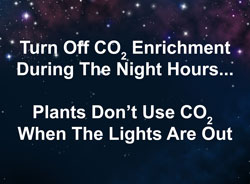 Because
plants actually stop "breathing in" CO2 at night, you can turn off your
CO2 enrichment system when the lights go out!
Because
plants actually stop "breathing in" CO2 at night, you can turn off your
CO2 enrichment system when the lights go out!
In fact, you can save money by having your CO2 enrichment turn on a half hour after your lights do, and turn off a half hour before your lights turn off.
In other words, have your CO2 off for about an hour longer than your dark period.
This will save you an hour’s worth of CO2 injection each day and in tests has proven this will not affect the CO2 effectiveness.
Learn More About CO2 Regulators & Timers
You must have already maxed out on your grow lights (light intensity) for CO2 enrichment to be effective.
It’s common for growers try to add CO2 to their grow area, without realizing that something else is limiting the growth of their plants.
Adding CO2 won’t help anything unless you’ve already maxed out other limiting factors, such as light intensity. Without big powerful grow lights, most growers aren’t able to achieve the right light intensity marijuana can naturally use at regular CO2 levels.
A good rule of thumb is you should have 7500-10000 lumens per sq foot in your grow area to get the full benefits of enriching with CO2.
To figure out if you have enough light, find out how much lumens your bulbs gives off (usually written right on the box your bulb comes in). Then multiply the length x width of your grow space to find the square footage (the area). Lumens/area should equal 7500-10000.
Examples of Setups with Enough Light for CO2 Injection
-
3' x 3' space - 600W HPS
-
3.5' x 3.5' space - 2 x 400W HPS
-
4' x 4' space - 1000W HPS
Learn more about HPS grow lights
Now that you've learned how to get better growth and bigger yields from CO2 injection, it's time to take the next steps. But you don’t need to figure this all out on your own! Learn about the different ways to supplement CO2...
How Can I Add More CO2 To My Grow Room?
There are 6 popular ways of adding CO2 to the air of your grow area...
- CO2 Generator <-- Recommended
- Compressed CO2 <--Recommended
- Dry ice
- Fermentation
- CO2 Bag
- Compost
1. CO2 Generator <-- Highly recommended
A CO2 generator burns propane, ethyl alcohol or natural gas to produce CO2 for your grow space.
Highly Recommended!
(as long as you use a CO2 generator with safety features)
Pros:
-
Many of these can be hooked up to a monitor for no-worries, automatic CO2 enrichment
-
Generates CO2 by burning propane, denatured alcohol, or natural gas
-
The smell from combustion can help cover up odors
Cons:
-
Increases humidity in a sealed grow room
-
Can produce heat
-
In order to burn enough fuel to reach the proper CO2 levels, you sometimes run into adverse side effects, such as producing an unhealthy amount of dangerous carbon monoxide. It's important to only use safe ways of generating CO2.
-
It’s dangerous to store your bottled fuels indoors (some people are able to use their municipal natural gas, and don’t need to store fuel, which makes this point moot for them).
Note: The cheaper methods of CO2 generation (like burning denatured alcohol in a small stove) make CO2 hard to regulate and can be very unsafe.... Don't use these methods! Only use a professional CO2 Generator!
Because these methods use an open flame and combustion to produce CO2 in a sealed area, there are many safety and fire concerns with this method. It's highly recommended that you buy a CO2 generator that has safety features to help prevent fires.
Learn more about getting set up with a CO2 generator
2. Compressed CO2 <-- Highly recommended
Compressed CO2 usually come in bottles or tanks. Compressed CO2 can be one of the most controlled ways of injecting CO2 to your grow space.
Highly Recommended!
-
Simple, effective way to get started
-
Ability to have fine control over PPM in room using a regulator or controller
-
Can be automated with a controller, so relatively automatic once everything is set up
Cons:
-
The equipment you need to get started is expensive, this is one of the most expensive ways to get started with enriching CO2
-
You must lug tanks of CO2 to and from your grow area, which is a possible security concern depending on your grow area and where you get your CO2
-
Tanks can explode if there’s a fire
-
You can enrich the air with CO2 beyond what’s safe for plants or people, so you must use great care to keep the PPM in the right range, and to avoid breathing air in your sealed grow area.
-
In some places, you may need a permit or license to get tanked or bottled CO2
Note: It’s usually cheaper to get tanked CO2 from a welding supply store as opposed to a hydroponics store
Learn more about getting set up with compressed CO2
3. Dry ice <-- Not recommended; costs too much time & money
Dry Ice is made of cold, solid CO2. As it warms up, it releases that CO2 into the air. While this method can be effective in the short term, it's incredibly expensive and time-consuming to keep this method going for long.
Not recommended!
Pros:
-
Very small cost to get started, since dry ice is relatively cheap and easy to obtain
-
The biggest safety hazard is burning your skin from touching the dry ice without protection
-
Does not raise temperature of grow room, in fact dry ice will slightly cool grow room
Cons:
-
Can be a huge pain and expense in the long run since dry ice doesn’t last long
-
Must manually keep adding dry ice at least once/day, which can be tough considering you need to keep an airtight seal in your grow room
-
Can be very tough to regulate the CO2 levels in the air
-
Dry ice must be used almost immediately, so you’ll be constantly going back for more
4. Fermentation <-- Not recommended; won't make enough CO2
Fermentation uses natural processes to produce CO2. Unfortunately this method will almost never produce enough CO2 to be effective.
Not Recommended!
Cons:
-
Very hard to produce enough CO2 to be effective
-
You can’t easily regulate the CO2 PPM levels
-
Can cause an unpleasant odor during the fermentation process
-
Impossible to automate; even if you manually check CO2 levels and take steps on a regular basis to keep the fermentation process going, it still won't produce enough CO2.
5. CO2 Bags <-- Not recommended; won't make enough CO2
CO2 bags use mycelial mass (fungi) growing on organic matter to produce CO2. Unfortunately they won't make enough CO2 for pretty much all setups.
Not recommended!
Cons:
-
Doesn't produce enough CO2 to be effective. Even in a very small space, growers may need to hang 4-5 or more bags (or more!) over their plants in order to achieve the right PPM in their grow area. Even then, I've never heard of any growers who use this method for long-term CO2 injection. They just don't work well enough for the price and time needed.
-
Some growers have trouble getting the fungus to grow properly (although you’re not supposed to need to do anything for these bags to work)
-
Even if you could make enough CO2, you still won't be able to regulate the CO2 PPM in your grow area so you can keep CO2 at optimal levels
6. Compost <-- Not recommended; won't make enough CO2
Some growers use the composting process, which produces a small amount of CO2. Like the other "natural" CO2 enrichment tools, it just doesn't make enough CO2 to be effective.
Not recommended!
Cons:
-
Often smelly and unsanitary
-
With home-made compost, it's almost impossible to produce enough CO2 to acheive 1200-1500 PPM
-
The pre-made systems like CO2 Boost are expensive and still don't produce enough CO2

Note: Breathing in the Grow Room Does Not Work!
Humans breathe out CO2 with every breath, and since that CO2 is free, it can be tempting to think you can add extra CO2 to your grow room, all natural, with no equipment needed.
Unfortunately this just isn't going to add enough CO2 to be effective. It's good to spend time with your plants, in fact I love hanging out in the grow room. But the facts show that breathing on your plants isn't going to make them grow any faster.
Use Only the Best CO2 Sources!
How To Get Started With a CO2 Generator or Compressed CO2
“The yeast or whatever they are methods are pretty pointless. I run at 1500 ppm. I've run CO2 for years. I've noticed larger yields, more heat tolerant plants, and sooner harvest times. I burn propane but I've used tanks for years prior. Highly recommend it.”
- Aquanaut38
So you’re ready to add CO2 to your cannabis grow room? These are the two methods used by commercial and pro growers who are serious about CO2 injection.
Option 1: Tanks or Bottles of Compressed CO2
Pros:
-
Simple, effective way to get started
-
Ability to have fine control over PPM in room using a regulator or controller
-
Can be automated with a controller, so relatively automatic once everything is set up
Compressed CO2 usually comes in metal containers that are under high pressure. It’s often cheaper to buy compressed CO2 from a welding supply store as opposed to a gardening or hydroponic store.
The most expensive part about adding CO2 to your grow room with compressed CO2 is the initial investment in parts. After that it's pretty cheap to refill your CO2 tanks.
Get Started with Compressed CO2
While it is expensive to get everything up front, a single tank of compressed CO2 could last several grows by itself, and refills are cheap when you find the right place.
If you have an automatic CO2 PPM monitoring system, it's simple to maintain the CO2 levels that you want.
If all you have is a compressed CO2 with a regulator and timer, you'll want to inject the room with CO2 for small periods of time while the lights are on, using your timer. You may have to measure the PPM of CO2 over time and keep adjusting how much CO2 is released until you figure out how to maintain a CO2 PPM between 1200-1500 PPM.
The nice CO2 tanks can be hooked up to a meter (a CO2 PPM meter) that measures how much CO2 is in the air and adjusts your CO2 output as needed.
For plant growth, you want your CO2 to be between 1200-1500 PPM. The meter is attached to your CO2 tank, and it will start injecting more CO2 into the air above your plants when CO2 levels drop below the optimum. This effectively automates the whole system.
Bottled CO2 can be purchased at many hydroponic or welding stores. These can come with a regulator/flow meter which you will need to adjust in order to output the correct amount of CO2.
To use this method of enriching CO2, you will need some special equipment:
1. Compressed CO2 (available at local welding supply stores, as well as some hydroponic stores)
2. Pressure regulator, Flow Meter and Solenoid valve
3. Either a CO2 PPM monitor / controller or a regulator with timer
4. Connecting tubing, fittings and adapters (usually comes with your set)
Watch a Youtube video showing the right way to use compressed CO2:
A CO2 generator burns propane, natural gas or occasionally denatured alcohol. This creates a chemical reaction that produces CO2 + water vapor.
Pros:
-
Many of these can be hooked up to a monitor for no-worries, automatic CO2 enrichment
-
Generates CO2 by burning propane, denatured alcohol, or natural gas
-
The smell from combustion can help cover up odors
The cheaper methods of producing CO2 this way (such as a bunsen burner) use an open flame, which is a terrible fire hazard, especially considering you are keeping temperatures above 85°F (30°C) when flooding your grow area with extra CO2.
Because of the hot temperature and the electrical equipment and water that are already in your grow area, I highly recommend NOT adding a cheap CO2 burner into your grow room and risking a fire.
However, more advanced CO2 generators have been specifically built for gardening applications, and these are a much better choice for a gardener as they’re built with many safety features. They may be water cooled, have an automatic shut-off feature, include a valve to handle municipal gas, an overheating sensor, a tipping sensor, and more.
Please note: As you’re burning propane or natural gas to get CO2, this chemical reaction also adds water vapor into the air and increases your humidity. The increase in humidity is even greater when you generate a lot of CO2 or have a very small grow area. This extra humidity can become problematic in some cases, especially since you must seal your grow area to keep the CO2 inside. If you’re not carefully monitoring the humidity, you may put your plants at increased risk for mold (remember, humidity should always be below 70% in vegetative, and below 60% in flowering). A strong dehumidifier may be what you’re looking for in this scenario.
To use this method of enriching CO2, you will need the following equipment:
1. CO2 Generator
2. Controller to regulate CO2 PPM in room and turn off CO2 injection at night
3. (Possibly) Dehumidifier
Keep in mind: How will you find propane or natural gas on a regular basis? Some homes get municipal natural gas, and this can sometimes be hooked up directly to a CO2 generator
Complete Climate Controllers & Timers
Some CO2 controllers can be integrated with a complete climate controller (often sold for people growing with hydroponics). A climate controller can monitor and adjust your fans, CO2 injection and other factors so you automatically maintain the right temperature, air movement, humidity and CO2.
If you’re not going to get a CO2 controller and need to use a timer...
If you’re not going to use a controller (which is what you want to do if you can afford it,) you will need to calculate how much CO2 to add to your grow area and use a timer to control how much CO2 gets added.
To calculate the amount of CO2 needed to enrich the air of a room to 1200-1500 ppm of CO2, this is what you do:
-
Calculate the volume of the growing area by multiplying width x length x height.
Example: If you had a closet that was 5 ft x 4 ft, and the ceiling is 8 feet high, you would multiple 5 x 4 x 8 = 160 cubic feet of space in your grow area. -
Determine the CO2 needed to enrich room to 1200 or 1500 ppm by multiplying the volume of space by 0.0012 or 0.0015 respectively.
Example: So to get 1200 PPM of CO2 in my 160 cubic feet closet, I’d multiple 160 x .0012 = 0.768 Thus, 0.192 cubic feet (or you can round up to 0.2 cu ft) of CO2 will be needed to bring the CO2 in this room up to 1200 ppm. When you’re buying tanks, 1 lb of CO2 is equivalent to ~8.5 cu ft. -
If you have a sealed room, then you will need to keep adding CO2 based on how much your plants are using. If the room is not sealed, you will need to replace CO2 at a rate equal to the amount plants use plus what’s being vented out. It’s recommended that you regularly test and monitor that CO2 levels are staying where you want them to be.
Because this is tough for most growers to calculate accurately, it’s highly recommended you get a controller that measures and regulates the amount of CO2, and adjust the CO2 injection based on the current readings!
A complete climate controller will make your life a lot easier!
Jump to...
10 Tips to Growing Top-Shelf Buds
Learn How to "ScrOG" Your Plants
Supercropping: Simple Secret for Bigger Yields

